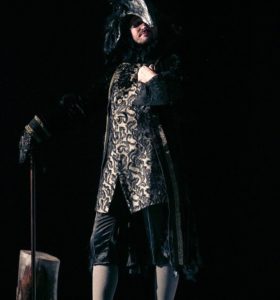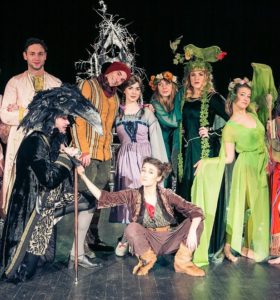„Snow queen” in Kraków. Last performance of the season!
| On Oct15,2018“Storia” historical-costume theatre – a joint project of the Nomina Rosae Foundation and the Ada Sari Culture and Arts Centre in Stary Sącz– invites for the last performance of the season of its first play “Snow Queen” based on Hans Christian Andersen.
The premiere took place on December 4th, and the play could have been seen on the stage of SOKÓŁ in Stary Sącz several times. On January 26th at 10:00 the last performance of the season will take place – this time at the Solvay Contemporary Art Centre in Kraków (62 Zakopiańska str.)
The Snow Queen is a road tale, a story of Gerda – a young girl who, driven by a devoted emotion sets on a journey to find her friend Kay. A magical story narrated in a very uncanny way will definitely captivate not only children, but also adults of all ages.
Tickets for the play at the price of 20 PLN; booking via phone at +48 795 401 937
The play was directed by Łukasz Głąb based on a script by Maria Molenda. Stage set was designed by Filip Przybyłko, and costumes were designed by Maria Molenda. The cast of the play are professional actors, graduates of state and private acting schools – Karolina Fortuna/Aleksandra Powęzka, Magdalena Szczepanek, Jakub Sokołowski, Marta Kontny, Wojciech Michno, Aneta Gierat, Rafał Pawłowski, Artur Smołucha, Agata Duda, Katarzyna Mikołajaczak, Karolina Lisik, Justyna Stasik/Joanna Sitko, Małgorzata Dorosiewicz and Katarzyna Sanocka.

Łukasz Głąb ( 1985) – graduate of Film & TV Producton Organization at Krzysztof Kieślowski Radio and Television Depertment of the Silesian University in Katowice. For the last few years he worked at productions in the Documentary and Feature Films Production in Warsaw, i.a. with the movies: “My Cichociemni”, “Galerianki”, “Różyczka” and co-directed the “Ojciec Mateusz” series. He worked as a producer and director of TV broadcasts (TVN, TTV, TVP) and many documentary forms. He also directs ads, video-arts and spectacles combining art with music and multimedia. He loves new artistic challenges, employing traditional and contemporary forms of art.
Snow queen was written by Hans Christian Andersen in 1844. Unlike his other fairy-tales, that were inspired by folklore or traditions of other nations, this story was born in the author’s imagination.
The fairy-tale describes the story of a couple of children – Gerda and Kay, who lived in friendship until one day, when a mysterious shard of devil’s mirror broken in the skies got into Kay’s eye, changing the way he saw the world. Everything beautiful and good he saw from then on as ugly and bad. The good boy turned into a naughty, mean and cruel child. Enchanted by winter and ice he tied his sledge to the carriage of unknown winter lady and went ahead into the unknown That lady was the Snow Queen ruler of the icy kingdom, a stramger to any warm, hearty feelings, whose biggest dream was to turn the whole world into an icy desert in the image of her own kingdom. Deserted and sad Gerda embarked on a search, on a long and dangerous journey to get her friend back and cure him…
“In 1805 in a small and sordid room a young marriage lived, who cared for each other very much He, a nearly 20-year old shoemaker, was a man of many talents and a truly poetic mind. His wife, several years older than him, didn’t know the world and life, but her heart was full of love. The young man on his own built a shoemaking workshop and bed frame, that he used to start furnishing the house. The frame was made of a wooden catafalque, on which a moment before the coffin of the late count Trampe rested…
But instead of a body of an aristocrat surrounded by crepe and wax candles, in April 1805 a living, weeping child rested. That child was me, Hans Christian Andersen.”
Hans Christian Andersen, „Autobiography. The fairy-tale of my life”
Andersen was born in the poorest district of Odense. His grandmother was the first to introduce him into the world of fairy-tales. In his childhood he dreamed of being an actor, so after his father’s death in 1819 he moved to Kopenhagen to get the proper education there. His acting dream didn’t come true, but despite that he got involved in theatre, creating many theatrical plays, which however didn’t bring him any renown. It came only after the success of his fairy-tales. The first fairy-tale collection (Eventyr fortalte for Børn – Fairy-tales told to children) was published in Kopenhagen in 1835, and the next volumes were published in 1836 and 1837. Encouraged by the success of the first series, the writer kept releasing next ones until 1872. Andersen believed, that his fairy-tales are like boxes – the children look at the wrapping and the adults are to look inside. He died in 1875 surrounded with general respect and adoration.


















